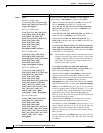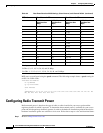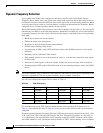
6-11
Cisco IOS Software Configuration Guide for Cisco Aironet Access Points
OL-29225-01
Chapter 6 Configuring Radio Settings
Configuring MCS Rates
Use the no form of the speed command to remove one or more data rates from the configuration. This
example shows how to remove data rates basic-2.0 and basic-5.5 from the configuration:
ap1200# configure terminal
ap1200(config)# interface dot11radio 0
ap1200(config-if)# no speed basic-2.0 basic-5.5
ap1200(config-if)# end
Configuring MCS Rates
Modulation Coding Scheme (MCS) is a specification of PHY parameters consisting of modulation order
(BPSK, QPSK, 16-QAM, 64-QAM) and FEC code rate (1/2, 2/3, 3/4, 5/6). MCS is used in 1140 and
1250 series 802.11n radios, which define 32 symmetrical settings (8 per spatial stream):
• MCS 0–7
• MCS 8–15
• MCS 16–23
• MCS 24–31
The 1140 and 1250 series access point supports MCS 0–15. High throughput clients support at least
MCS 0–7.
MCS is an important setting because it provides for potentially greater throughput. High throughput data
rates are a function of MCS, bandwidth, and guard interval. 802.11 a, b, and g radios use 20-MHz
channel widths. Table 6-2 shows potential data rates based on MCS, guard interval, and channel width.
Note The 2.5 GHz radios do not support 40 MHz channel width.
speed (continued) On the 802.11n 2.4-GHz radio, the default option sets
rates 1.0, 2.0, 5.5, and 11.0 to enabled.
On the 802.11n 5-GHz radio, the default option sets rates
to 6.0, 12.0, and 24.0 to enabled.
The default MCS rate setting for both 802.11n radios is
0–15.
Step 4
end Return to privileged EXEC mode.
Step 5
copy running-config startup-config (Optional) Save your entries in the configuration file.
Command Purpose
Table 6-2 Data Rates Based on MCS Settings, Guard Interval, and Channel Width
MCS Index Guard Interval = 800ns Guard Interval = 400ns
20-MHz Channel
Width Data Rate
(Mbps)
40-MHz Channel
Width Data Rate
(Mbps)
20-MHz Channel
Width Data Rate
(Mbps)
40-MHz Channel
Width Data Rate
(Mbps)
0 6.5 13.5 7 2/9 15
1 132714 4/930


















